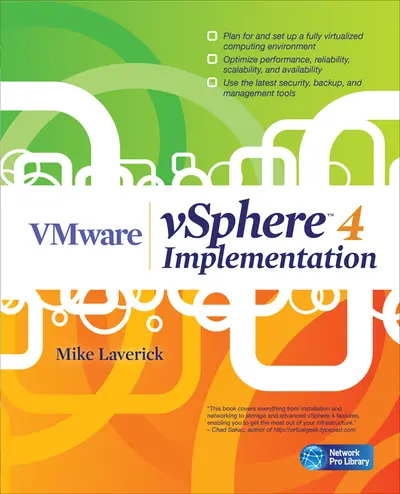My Account Details

ISBN10: 0071664521 | ISBN13: 9780071664523

Step 1 . Download Adobe Digital Editions to your PC or Mac desktop/laptop.
Step 2. Register and authorize your Adobe ID (optional). To access your eBook on multiple devices, first create an Adobe ID at account.adobe.com. Then, open Adobe Digital Editions, go to the Help menu, and select "Authorize Computer" to link your Adobe ID.
Step 3. Open Your eBook. Use Adobe Digital Editions to open the file. If the eBook doesn’t open, contact customer service for assistance.
Publisher's Note: Products purchased from Third Party sellers are not guaranteed by the publisher for quality, authenticity, or access to any online entitlements included with the product.
Evolve to a virtual network infrastructure using VMware vSphere 4
Design and deploy a high-performance cloud-based enterprise IT platform with guidance from a VMware expert. Featuring tips, techniques, and best practices, VMware vSphere 4 Implementation explains how to dramatically cut hardware costs, maximize computing power, and centralize system administration. Configure hardware and storage devices, build virtual machines and networks, install guest operating systems, and import physical machines. Security, disaster recovery, performance tuning, and system updates are also covered in this comprehensive resource.
- Perform a clean VMware vSphere 4 install or migrate existing systems
- Build Distributed Virtual Networks using DvSwitches and VMotion
- Manage SAN, NAS, iSCSI, and fiber channel storage devices
- Construct VM and provision new copies of Windows/Linux from vCenter
- Automate server maintenance with the Distributed Resource Scheduler
- Set up multiple security zones, users, permissions, roles, and privileges
- Maximize uptime using VMware High Availability and Fault Tolerance
- Work with VMware Consolidated Backup, vDR, and Update Manager
Mike Laverick is a VMware Forum moderator and member of the London VMware User Group steering committee. He is the sole author of the virtualization website/blog, RTFM Education. Mike recently received the vExperts Award from VMware.
Need support? We're here to help - Get real-world support and resources every step of the way.